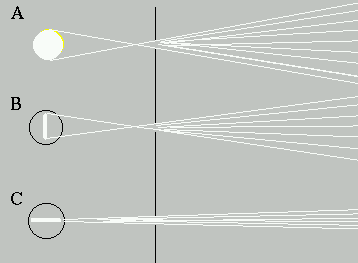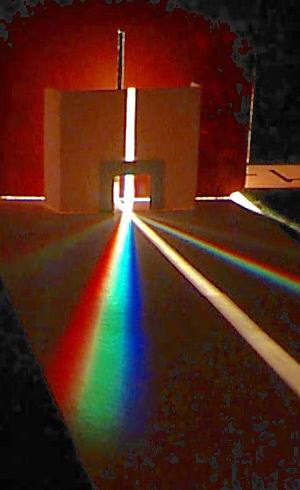
A. A frosted bulb makes a wide, fuzzy beam
B. A clear light bulb doesn't work well if it is turned the wrong way
C. Aiming the filament towards the slot makes a good beam
(These light bulbs are seen from above)
We can use the light station to make it clear that light travels in a straight line through air, and to study what happens when light bumps into something. We have also removed another distracting aspect: usually at any point in space there is light travelling many different directions, from all the different light sources around the room. Even when we have only one light source, we have light travelling from the different parts of it. The light beam we make single-slot mask has all of its light travelling the same direction (almost).
The type of light bulb being used to make the beam has an important effect on the quality of the beam. Of course it is important that the bulb is clear, rather than frosted. However, it is also important that the filament of the light bulb is in the form of an inverted V. If you view the light bulb from the right direction, it just looks like a vertical line. This causes it to give exceptionally sharp-edged shadows of a vertical slot, and will produce a sharply edged light beam.
 |
Different bulbs make different beams
A. A frosted bulb makes a wide, fuzzy beam B. A clear light bulb doesn't work well if it is turned the wrong way C. Aiming the filament towards the slot makes a good beam (These light bulbs are seen from above) |
A light beam is really a kind of shadow -- it is light enclosed by shadows.
Putting the diffraction grating into the beam shows that only part of
the light is deflected to make the spectrum that we see, and that the deflection
is at an angle that is characteristic of the wavelength of the light.
Perhaps it helps explain some of the observations we made earlier about
diffraction gratings and color filters.
 Box:
Box:
Brightness of light